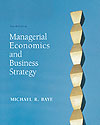 |  Managerial Economics and Business Strategy, 4/e Michael Baye,
Indiana University - Bloomington
Key FeaturesHeadlines
As in previous editions, each chapter begins with a headline that is based on a real-world economic problem – a problem that students should be able to address after completing the chapter. These headlines are essentially hand-picked mini-cases designed to motivate students to learn the material in the chapter. Each headline is answered at the end of the relevant chapter – when the student is better prepared to deal with the complications of real-world problems. Reviewers as well as users of previous editions praise the headlines as student motivators and a way to show students how to use economics to make business decisions.
Demonstration Problems
The best way to learn economics is to solve many economic problems. So, in addition to the headlines, each chapter contains many demonstration problems sprinkled throughout the text along with detailed answers. This provides students with a mechanism to verify that they have mastered the material, and reduces the cost to students and instructors of having to meet during office hours to discuss answers to problems.
Inside Business Applications
Each chapter contains boxed material that illustrates how theories explained in the text relate to a host of different business situations. As in previous editions, I have tried to strike a balance between applications drawn from the current economic literature and the popular press.
Calculus and Non-Calculus Alternatives
Users can easily include or exclude calculus-based material without losing content or continuity. That’s because the basic principles and formulae needed to solve a particular class of economic problems (e.g., MR = MC) are first stated without appealing to the notation of calculus. Immediately following each state principle or formula is a clearly marked calculus alternative. Each of these calculus alternatives states the preceding principle or formula in calculus notation, and explains the relation between the calculus and non-calculus based formula. More detailed calculus derivations are relegated to appendices. Thus, the book is designed for use by instructors who want to integrate calculus into managerial economics, and by those who do not require calculus.
Key Terms and Marginal Definitions
Each chapter ends with a list of key terms and concepts. These provide an easy way for professors to glean material covered in each chapter, and for students to check their mastery of terminology. In addition, marginal definitions are provided throughout the text.
End-of-Chapter Problems
Each chapter of the 4th edition contains entirely new end-of-chapter problems. By popular demand, two types are offered: Highly structured but nonetheless challenging Conceptual and Computational Questions stress fundamentals. Problems and Applications are far less structured and, like real-world decision environments, may contain more information than is actually needed to solve the problem. Many of these applied problems are based on actual business events. Answers to selected problems are presented at the end of the book; detailed answers to all problems are available to instructors in the Instructor Manual as well as on the Instructor CD in MS Word format.
Flexibility
Instructors of managerial economics have genuinely heterogeneous textbook needs. Reviewers and users continue to praise the book for its flexibility, and assure us that sections or even entire chapters can be excluded without losing continuity.
Learning CD
Each text includes a Learning CD that contains files to help students get hands-on experience at making economic decisions. THE CD includes data needed for various regression problems. Spreadsheet versions of key tables in the book enable students to see how key economic concepts such as marginal cost and profit maximization can be implemented on standard spreadsheets. There are also spreadsheet macros that students can use to find the optimum price and quantity under a variety of market settings, including monopoly, Cournot oligopoly, and Stackelberg oligopoly.
|
|




 2002 McGraw-Hill Higher Education
2002 McGraw-Hill Higher Education


 2002 McGraw-Hill Higher Education
2002 McGraw-Hill Higher Education